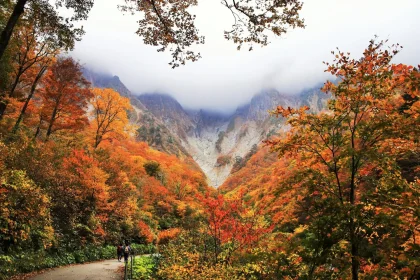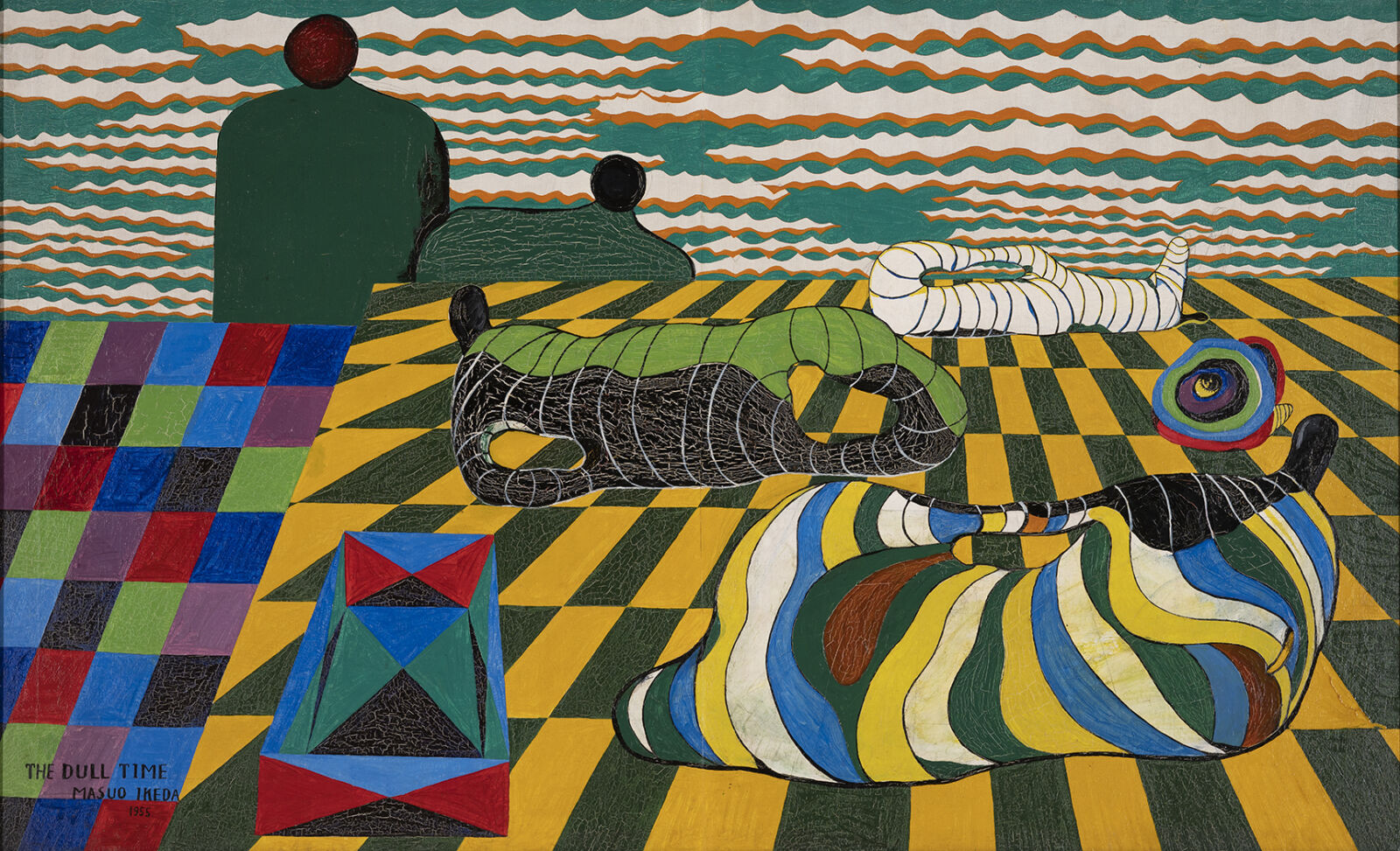
Following the conclusion of their Hokusai Exhibition, Nagano Prefectural Art Museum once again invites you to the remainder of their 2023 season with three incredibly diverse Special Exhibitions:
“Moments to Fly Up: Ikeda Masuo and the Democrato Artists,” is a tribute to the multitalented artist Ikeda Masuo, a Nagano-related progressive that left an indelible mark on the art world. This exhibition, running from September 9th to November 5th, revisits the era of Japanese printmaking that flourished from the 1950s to around 1966, featuring Ikeda’s works and those of artists who influenced him.
Following this engaging exploration, we delve into the world of animation and creativity with HIDEAKI ANNO EXHIBITION,” set to run from November 25th, 2023, to February 18th, 2024. Celebrating the renowned director Hideaki Anno, most recently known for his extraordinary contribution to “Shin Evangelion Theatrical Version,” which achieved over 100 billion yen in box office success. This exhibition provides an all-encompassing look at his works as an animator, director, and producer, unveiling the secrets behind his creative process.
Lastly, we pay tribute to the birth centenary of the “Shunyo-Kai” artistic society in “Artists of Shunyo-Kai: Celebrating Its 100th Anniversary,” which runs from March 16th to May 12th, 2024. Established in 1923, the Shunyo-Kai showcased the diversity of artistic expression, embracing various genres that were inspired from Western pursuits, such as oil painting, sketching, illustration, and printmaking. This exhibition, featuring approximately 100 works, primarily focuses on pieces exhibited since the society’s inception.
In the sections below, you will find more information about each specific exhibition, and as their dates draw closer, this page will be updated with more detailed information as they become published by the Nagano Prefectural Art Museum!
Moments to Fly Up: Ikeda Masuo and the Democrato Artists
- Exhibit Dates: September 9th - November 5th, 2023 (CLOSED Wednesday)
- Business Hours: 9:00-17:00 (Exhibition room entry until 16:30)
- Ticket Prices: 800 yen (adult); 600 yen (university students and seniors aged 75+)
- Free admission for people under 18 years of age
- Nagano Prefectural Art Museum: 1-4-4 Hakoshimizu, Nagano City, Nagano Prefecture 380-0801
- More information, including transport information, located at the bottom of the article
It has been a quarter-century since the passing of Ikeda Masuo in 1997. Reflecting on how widely his print artworks were acclaimed around the world and how passionately he pursued the path of an artist holds great significance today.
Ikeda Masuo was born in 1934 in the former Manchukuo, Mukden, and relocated to Nagano with his parents in the year of Japan’s surrender. After graduating from Nagano Kita High School (now Nagano High School), he aspired to become a painter and moved to Tokyo. He made three attempts to enter the Tokyo University of the Arts, but all ended in failure. It was around this time in 1955 that he encountered Ay-Ō, through whom he got to know Ei-Q, the co-founder of the Democrato Artists Association, and art critic Kubo Sadajirō.

The artists of the Democrato put considerable effort into creating prints that could be seen by many, following Ei-Q’s advice. Ikeda, a young artist at the time, joined in these activities. He deepened his relationships with artists like Izumi Shigeru, Yoshihara Hideo, and Katō Tadashi. With the support of Kubo, Ikeda also dedicated himself to creating copperplate prints.
In the post-war era, as Japan was recovering its national strength, it hosted the inaugural Tokyo International Print Biennale Exhibition in 1957, the country’s first international contemporary art exhibition. Many artists from the Democrato, including Ikeda, participated and were selected. This event became a turning point for their careers. However, in the same year, Ei-Q decided to dissolve the Democrato Artists Association. Young artists continued to vigorously explore the possibilities of printmaking, and Ikeda, in particular, received international recognition, winning the International Grand Prize in the printmaking category at the 1966 Venice Biennale.
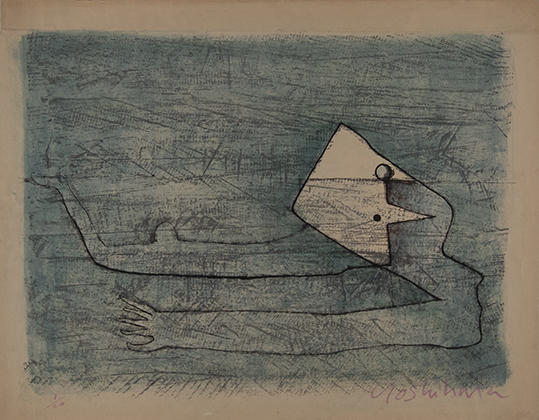
In this exhibition, we present Ikeda Masuo’s artworks from the 1950s to around 1966, alongside the works of artists who influenced him or had connections with him. We look back on the era when Japanese art made a significant impact on the world.
What You Can Expect to See at the Gallery
Section 1 – Encounter with the Democrato: 1950-1956 (Gallery 1)
In Gallery 1, immerse yourself in the birth of the Democrato Artists Association, where visionaries like Ay-Ō, Izumi Shigeru, and Yoshihara Hideo converged, exploring new expressions with printmaking as their cornerstone. Simultaneously, Ikeda Masuo, who journeyed from Nagano to Tokyo, founded the “Jitsuzai-sha” group in 1955 with Ay-Ō and others. Despite its dissolution the following year, Ikeda’s encounter with Ei-Q propelled him toward the Democrato Artists’s activities and a profound commitment to printmaking.
Section 2 – Ei-Q as a Beginning: 1950-1957 (Gallery 1)
In the same gallery, discover the influential Ei-Q, who, in 1951, boldly established the Democrato Artists Association, challenging existing art group’s exhibitions at the time, and aimed to use different media to express their art. He became a theoretical and spiritual guide for young artists, fearlessly exploring media like oil painting, watercolor, photo-dessin, etching, and lithography, pioneering new frontiers in expression, deeply influencing artists like Ikeda Masuo.
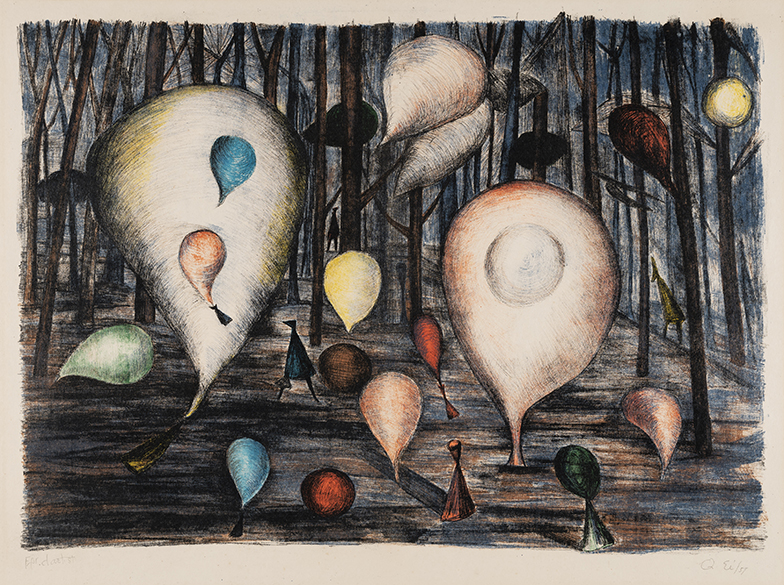
Section 3 – Before Dawn in 1957 (Gallery 2)
Moving to Gallery 2, experience the pivotal year 1957 when the inaugural Tokyo International Print Biennale took place. Ikeda Masuo and many Democrato artists won a prize, fueling a burgeoning passion for printmaking. Izumi Shigeru, in particular, received the Newcomer’s Encouragement Award for his piece “Fighting Cocks.” Yet, on the opening day of the exhibition, Ei-Q announced the Democrato Artists Association’s dissolution, concluding the association’s activities in just six years.
Section 4 – Each Taking Flight: 1958-1966 (Gallery 2)
Continuing in Gallery 2, explore the post-Democrato era when artists ventured beyond their artistic boundaries. They explored various forms of expression, transitioning from printmaking to painting and even relocating their creative hubs abroad. The 1960s saw an increase in artists being selected for international exhibitions, marking a true era of artistic flight.
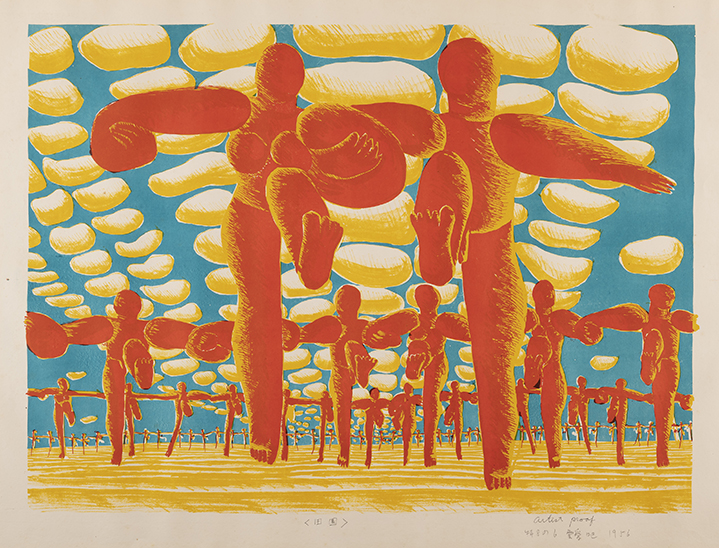
Section 5 – Ikeda Masuo: Moments to Fly Up: 1958-1966 (Gallery 3)
In Gallery 3, delve into Ikeda Masuo’s remarkable journey. From winning the Minister of Education Award at the 1960 Tokyo International Print Biennale to consecutive victories until the fourth edition, Ikeda’s path to recognition was unwavering. In 1965, he made history as the first Japanese artist to hold a solo exhibition at the Museum of Modern Art in New York. The following year, he secured the International Grand Prize at the Venice Biennale, establishing his status as an internationally acclaimed artist.
This exhibition offers not only a glimpse into these distinct eras but also a comprehensive exploration of the evolution of Japanese printmaking during this transformative period through the lens of several artists.
HIDEAKI ANNO EXHIBITION
- Exhibit Dates: November 25th – February 18th, 2024 (CLOSED Wednesday, December 27th - January 3rd)
- Business Hours: 9:00-17:00 (Exhibition room entry until 16:30)
- Advance Ticket Prices: 1,500 yen (general admission); 1,200 yen (university students and high school students)
- Same-day Ticket Prices: 1,700 yen (general admission); 1,400 yen (university students and high school students)
- Free admission for people of middle school age or younger.
- Nagano Prefectural Art Museum: 1-4-4 Hakoshimizu, Nagano City, Nagano Prefecture 380-0801
- More information, including transport information, located at the bottom of the article
Hideaki Anno is a man who truly requires no introductions, as his mark on Japanese media has left a lasting impression on those young and old across the planet. In his eponymous exhibition, Nagano Prefectural Art Museum presents a comprehensive showcase about the creative journey of this true visionary.
Recently renowned for his exceptional work as the chief director of “Evangelion: 3.0+1.0 Thrice Upon a Time,” which achieved unprecedented box office success exceeding 100 billion yen, Anno has yet again been thrust into the cultural zeitgeist of popular culture. This exhibition invites you to delve into Anno’s artistic evolution, from his early days as an animator helping Hayao Miyazaki to his current roles as an renowned director and producer that has left his mark on Japanese media forever.
Exhibition Highlights
- Immerse yourself in the complicated history of Hideaki Anno’s past works and latest achievements.
- Explore the secrets behind his innovative and captivating creative process.
- Experience the essence of Hideaki Anno’s beginnings through original drawings and miniatures from his “anime” and “special effects” works.
- Witness the diversity of production materials that shaped his artistic foundation.
Artists of Shunyo-Kai: Celebrating Its 100th Anniversary
- Exhibit Dates: March 16th – May 12th, 2024 (CLOSED Wednesday, open on March 20th, closed March 21st)
- Business Hours: 9:00-17:00 (Exhibition room entry until 16:30)
- Ticket Prices: 800 yen (general admission); 600 yen (university students and seniors aged 75+)
- Free admission for people under 18 years of age.
- Nagano Prefectural Art Museum: 1-4-4 Hakoshimizu, Nagano City, Nagano Prefecture 380-0801
- More information, including transport information, located at the bottom of the article
The Shunyo-Kai, established in 1923, emerged as the third major group in the yōga (Western-style painting) field, led by members including Kosugi Misei (Hōan), Yamamoto Kanae, and Morita Tsunetomo, who had departed from the Saikōin Exhibition Yōga Department, as well as Kishida Ryūsei of Sōdosha. Unbound by conventions, Shunyo-Kai emphasized the freedom to honor artists’ intentions and featured a diverse range of genres for display, not limited to oil painting, but also encompassing sketches, illustrations, and prints. This set it apart from other groups and led to distinctive developments.
This exhibition will showcase approximately 100 works, primarily those exhibited in Shunyo-Kai exhibitions since its founding.
Exhibition Highlights
- Discover the profound impact of the Shunyo-Kai Association on the yōga realm in Japan.
- Experience the freedom of artistic expression that sets Shunyo-Kai apart from other groups that were developing art at the time.
- Delve into the world of Kosugi Misei (Hōan), Yamamoto Kanae, Morita Tsunetomo, and Kishida Ryūsei.
- Immerse yourself in diverse genres such as oil paintings, illustrations, and prints.
Public Transport Information
As there is no general visitor parking available at the Nagano Prefectural Art Museum, use of public transport is encouraged. Traveling to the Nagano Prefectural Art Museum is convenient, with various transportation options available.
Option #1 – From the No.1 bus stop of the Zenko-ji Exit bus station at the JR Nagano Station
Take either:
- Alpico Route 11 bound for 'Uki' via Zenko-ji Temple
- Route 16 bound for 'Wakatsuki Higashijo' via Zenko-ji Temple and 'Wakatsuki Danchi'
- Route 17 bound for ‘Wakatsuki Higashijo’ via Zenko-ji Temple and ‘Nishijo’
Get off at the ‘Zenko-ji-kita’ bus stop. The museum is a 5-minute walk east from the stop.
Option #2 – From the No.1 bus stops of the Zenko-ji Exit bus station at the JR Nagano Station
Do the following:
- Take the Binzuru-go buses bound for Zenko-ji Temple, and get off at the 'Zenko-ji Daimon' bus stop (The ride takes approximately 13 minutes)
- Walk along the road that approaches the main shrine up to the main hall of the Zenko-ji Temple
- then turn right toward Joyama Park (approximately a 10-minute walk)
On weekends and holidays, get off at the Joyama Koen-mae bus stop.
Option #3 – Taking a local train from Nagano Station
- Take the Nagano Dentetsu Train Line northbound
- Get off at Zenko-ji-shita Station
- Walk toward Joyama Park (approximately 10 minutes)
We certainly wish to see you at the next several special exhibitions by the Nagano Prefectural Art Museum for the remainder of their 2023-2024 season!














